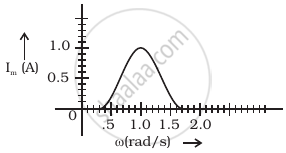Advertisements
Advertisements
प्रश्न
Why does current in a steady state not flow in a capacitor connected across a battery? However momentary current does flow during charging or discharging of the capacitor. Explain.
उत्तर
In steady state condition, voltage across the capacitor nearly equals to the voltage of the charging source. Hence net voltage acting in the circuit is zero. Due to this there is no flow of charge (current) through the circuit and hence the capacitor.
Now we know for an uncharged capacitor the potential difference across the capacitor is zero. So when it is connected to a battery, the battery begins to charge it by withdrawing the free electrons from one plate connected with the positive terminal of the battery of the capacitance and deposit on the other plate of the capacitor. So, due to this flow of charge, there exist a momentary current while charging of the capacitor. Now when the capacitor is fully charged i.e. voltage across the capacitor nearly equals to the voltage of the charging source, the current in the circuit vanishes.
Now in case of discharging of a charged capacitor, the battery gets replaced by a wire of say resistance R. Hence the capacitor itself acts as a battery now and flow of charge exists in the circuit from negative plate to the positive plate of the battery. This leads to momentary current in the circuit. As soon as the all the positive charges on one plate gets neutralised by the negative charges on the other plate, the flow of charge stops and hence the current.
APPEARS IN
संबंधित प्रश्न
An LR circuit with emf ε is connected at t = 0. (a) Find the charge Q which flows through the battery during 0 to t. (b) Calculate the work done by the battery during this period. (c) Find the heat developed during this period. (d) Find the magnetic field energy stored in the circuit at time t. (e) Verify that the results in the three parts above are consistent with energy conservation.
(i) An a.c. source of emf ε = 200 sin omegat is connected to a resistor of 50 Ω . calculate :
(1) Average current (`"I"_("avg")`)
(2) Root mean square (rms) value of emf
(ii) State any two characteristics of resonance in an LCR series circuit.
A series LCR circuit with R = 20 Ω, L = 1.5 H and C = 35 µF is connected to a variable-frequency 200 V ac supply. When the frequency of the supply equals the natural frequency of the circuit, what is the average power transferred to the circuit in one complete cycle?
In an LCR series a.c. circuit, the voltage across each of the components, L, C and R is 50V. The voltage across the LC combination will be ______.
Assertion: When the frequency of the AC source in an LCR circuit equals the resonant frequency, the reactance of the circuit is zero, and so there is no current through the inductor or the capacitor.
Reason: The net current in the inductor and capacitor is zero.
In series LCR circuit, the phase angle between supply voltage and current is ______.
A series LCR circuit contains inductance 5 mH, capacitance 2µF and resistance ion. If a frequency A.C. source is varied, what is the frequency at which maximum power is dissipated?
In series LCR circuit, the plot of Imax vs ω is shown in figure. Find the bandwidth and mark in the figure.

A series LCR circuit containing a resistance of 120 Ω has angular resonance frequency 4 × 105 rad s-1. At resonance the voltage across resistance and inductance are 60 V and 40 V respectively. At what frequency the current in the circuit lags the voltage by 45°. Give answer in ______ × 105 rad s-1.
Draw a labelled graph showing variation of impedance (Z) of a series LCR circuit Vs frequency (f) of the ac supply. Mark the resonant frequency as f0·
